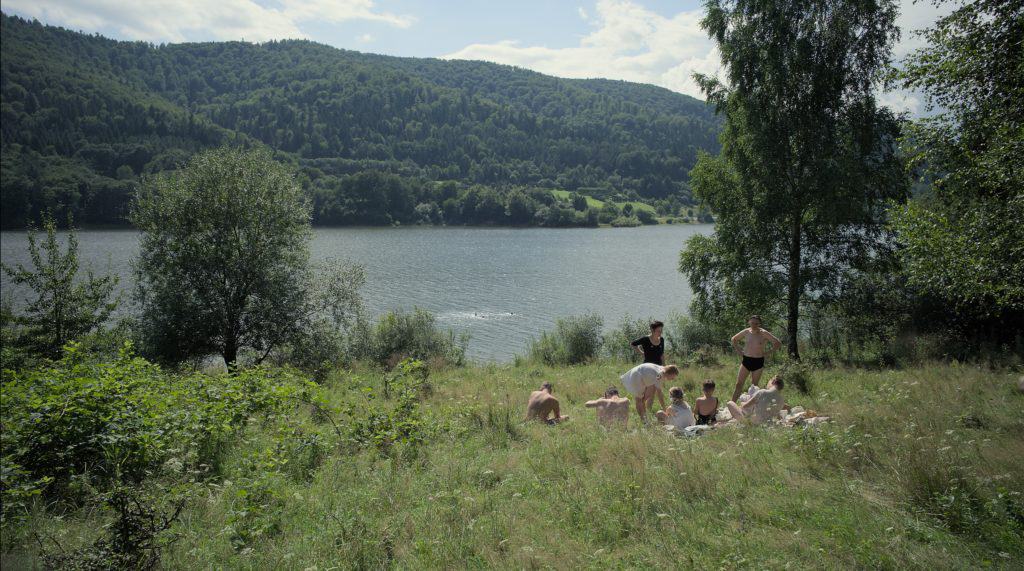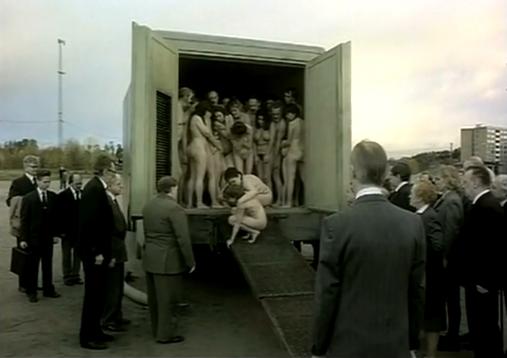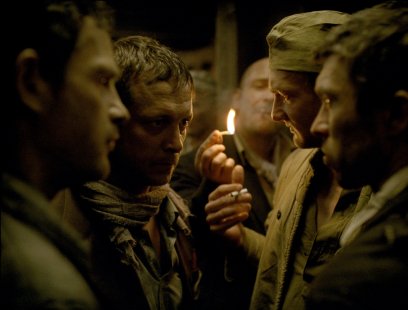The term “The Zone of Interest”, as explained by author Martin Amis, referred to the outer area of Auschwitz (Oświęcim in Polish) during WWll. The “interest” part referred to the economic value rather than the area itself being particularly interesting. Amis’ eponymous book was released in 2014 and was a major success. Jonathan Glazer’s The Zone of Interest is an adaptation of Amis’ book, even though it deviates substantially from it. The director chose one of the three viewpoints in the book, which depicts the life of the Höss family, where Rudolf (Christian Friedel) is the concentration camp commander. He lives next to the camp with his wife, Hedwig (Sandra Hüller) and their children, only separated by a wall.
The story part of the film begins with the family enjoying a swim in the beautiful surroundings. Everything feels idyllic, but anyone who enters a cinema to see this film will obviously know what the topic of the work is. Few people will be led to believe this is merely a film about some random Germans, so it doesn’t matter if that info doesn’t come to the audience through the usual kind of exposition. Nevertheless, this is a point that seems to have impressed some critics. Considering what occurs before this sequence, the reaction is even more surprising. The Zone Of Interest begins in darkness with noise and the first nuggets of Mica Levi’s brooding score.

In that regard, it’s similar to Roy Andersson’s debut feature, En Kärlekshistoria (A Swedish Love Story), which also begins in darkness with an orchestrated version of Björn Isfält’s score that will later appear in the film in different iterations. When the film was released on DVD, Andersson commented that it felt like a pretentious choice now. In that case, I disagree with him, but In Glazer’s film, that was the feeling I had. During the press conference, a rather peculiar question was asked about this. The answer was that Glazer and Levi were discussing how to enter the film, talking about creating a space and the I-word is mentioned, as well.1 Immersion
That statement raises questions about the formal aspects of the film and what form really entails. To me, it’s obvious that it concerns conceptual elements. If the concept is not well thought out, the quality of the single parts makes little difference. It should be noted that this is a film with significant qualities from several accomplished artists, from the cinematography of Łukasz Żal (even though he joked that he felt like a multi-camera system supervisor), the editor, Paul Watts, the composer Mica Levi, the production designer Chris Oddy, and costume designer Małgorzata Karpiuk, to name a few.
The Banality of The Zone of Interest
In my piece about the Cannes Awards, I referred to Levi’s score as “incessant”. With the most common definition of the term, that was unfair. It doesn’t appear that often and is actually utterly accomplished in its own right. My reaction to it was the way it was utilised in the film. Not unlike The Childhood of a Leader (2015), the way the music is used draws attention not only to itself but signals that what we are watching is something of great significance. With all the talent on display, The Zone of Interest remains a banal depiction of evil. The professed rigour is genuinely lacking in the film itself. It’s more of a display of the concept of rigour.
The purported austerity of the film made me think about Haneke, but I felt it would feel cheap to mention him. Then, Christian Friedel said at the press conference that he regards the film as a sequel to Das weiße Band (The White Ribbon 2009), where he played one of the leading parts, so trying to avoid the obvious reference feels meaningless. Another reference could be the aforementioned Andersson and his short Härlig är jorden (World of Glory 1991), where the main idea seems to be that the affluence of the modern world rests on former atrocities. In my mind, it’s Andersson’s most successful film in the new style introduced with that film.

Another Trick in the Wall
The wall that separates the Höss family and Auschwitz is never crossed by the camera in the film. There are odd sounds crossing over, and we see smoke on the other side that, with few exceptions, seems to affect the family. Once you get that idea, the rest of the film becomes a plodding exercise. One attempt at a flourish concerns thermal imagery but amounts to little more than the red coat in Schindler’s List (1993). As accomplished as the parts stand, the film itself amounts to little more than a cheap trick.
When I visited Auschwitz in 1993, I had a Lonely Planet Guide that described how to make it through as fast as possible using a taxi. To the editor’s credit, he acknowledged the reactions he received against this “American tourist approach”. I was sceptical initially with the words from Hiroshima mon amour (1959) echoing in my mind, “Tu n’as rien vu à Hiroshima”, and I figured it would be just visiting another museum. In fact, it was a momentous experience from the vastness of the camp (especially Birkenau) to the stories told by former inmates. The walk along the train track from Auschwitz to Birkenau and the sheer size of the latter will always be engraved in my mind.
Au fond, c’est une histoire banal
The quote comes from Alain Resnais’ third feature, Muriel (Muriel ou le temps d’un retour 1963), which deals with the war in Algeria, without any images from there. The exception is a piece of film played briefly that burns in front of our eyes. The script was written by Jean Cayrol, a concentration camp survivor who also scripted Nuit et Brouillard (Night and Fog 1956). The story manages to convey the atrocities indirectly, but it is not limited to that concept. I won’t expand more on the themes in that film, which, in my mind, is one of the greatest films ever made. Another quote from the film is, “Every person is a whole world”.
One of the storylines in Amis’ book that Glazer left out concerns the Sonderkommando. That’s a reminder of yet another film vastly superior to this one: Saul fia (The Son of Saul 2015). In László Nemes’ film, the form is congenial with the subject matter throughout, and all the brilliant elements come together as a cohesive whole. Like The Zone of Interest, it won the Grand Prix in a significantly stronger competition. One of the most puzzling aspects of the film’s reception is those critics who labelled it experimental. I rather feel that it’s a film that does what is expected, and watching it amounts to little more than watching someone filling in a colouring book.

It should be noted that I watched The Zone of Interest on the festival’s closing day, eight days after the premiere screening, so I had witnessed some reactions but hadn’t read any reviews yet. I don’t think that makes much difference, but I still want to be transparent. The Grand Prix came as no surprise since the film has that quality where it exudes confidence in its own importance. Even though I found the film conventional on many levels, it is still several cuts above any Palme d’Or winner of the last decade, with the exception of Parasite (2019). It will, without any doubt, be highly successful on the festival circuit in the upcoming months.
When it comes to the idea that it’s shocking to see ordinary people responsible for heinous acts, there is an irony, just like last year with Triangle of Sadness. When people shocked by the banal quality of the deeds committed in the concentration camps make fun of the (admittedly rich) people who died in the recent horrific submarine accident, it’s a chilling reminder of how little it takes to label other people as not worthy of life. The lesson might be that we all need to do some continuous soul-searching. Going back to the film, it is often said that the devil is in the details, but sometimes, the crucial detail might lie in the overall structure.
Anyone interested in the film would find interest in watching the Cannes press conference, preferably after watching the film.

